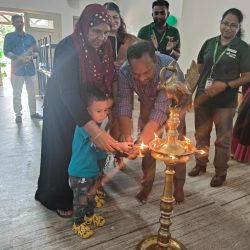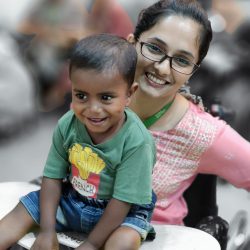Letter from Trivandrum
 Smiles. I am seeing them everywhere in India. To my surprise, many of the most radiant are on the faces of Pallium India’s patients.
Smiles. I am seeing them everywhere in India. To my surprise, many of the most radiant are on the faces of Pallium India’s patients.
I’m here in Trivandrum to get a first hand look at the organization’s work. I first met Dr. M.R. Rajagopal, founder and chairman of Pallium India at a conference on Hospice and Palliative Care in the Global Community, held last fall at UCSF Fresno and sponsored by Hinds Hospice.
One of the first patients I encounter here is a 53-year-old woman with a rare, extremely painful and serious condition known as systemic sclerosis. Dr. Rajagopal treats her at the organization’s Pain and Palliative Care Unit, which is a joint project with the local S.U.T Hospital. He sets her immediately at ease – something I’ll see over and over again. It’s hard not to be in awe of his competent, compassionate care.
This woman’s condition means she is slowly losing her fingertips, which she shows me by laying her hands on the table. One of her toes and part of another have also needed amputation — all of this due to her blood supply being cut off by the sclerosis. Upon her original diagnosis, she was given three months to live. That was five years ago. By some sort of miracle or effort of will, she continues on. Even more unbelievably, she does it with a smile.
Dr. Rajagopal tells me her attitude continually amazes him.
“She is my guru,” he says, referring to the almost godlike air around her and her ability to handle immense pain and uncertainty about her future.
It’s not what anyone would imagine seeing on the face of a person who is often at a “10” on the pain scale. (This scale starts at “0” for no pain and runs to “10” for the worst pain imaginable.) Her smile is a wide as her face, accompanied by a bright twinkle in her bright blue-gray eyes. Her cracked teeth are spaced far apart. When she smiles it looks as if her entire being is infuse d by some wellspring of private joy. Pain cannot touch it, and in this, she touches everyone around her.
d by some wellspring of private joy. Pain cannot touch it, and in this, she touches everyone around her.
Later on she shows me to her hospital room, where her daughter is sitting on the edge of one of the beds, nursing her baby in her lap. The other child, a little girl of perhaps five or six, hides shyly behind grandma’s skirts. Here are the living reasons she continues to travel here regularly from her village 220 km away to brave the delicate and painful procedure known as stellate ganglion neurolysis that Dr. Rajagopal performs to restore blood flow to her limbs, thus keeping her alive.
Now covered in a thin blue blanket, she lies on a gurney in the operating theater. Her eyes are open. She is given local anesthetic, never flinching as the needle enters her arm. After it takes effect, she calmly accepts the next step, application of a needle to her neck. Dr. Rajagopal carefully injects dye, which shows up on a computer screen in front of him. It looks like tiny black snail shell. I find out later that this is a procedure few doctors are willing to perform, because of the danger of accidentally hitting the nearby carotid artery and almost certainly killing the patient. After it’s over, she turns her head and gives me another one of her dazzling smiles.
A few days later I meet another patient, a 35-year-old man who suffered a terrible accident ten years ago. While working at a construction job, a wall collapsed on him, leaving him paralyzed from the waist down. His family’s livelihood was essentially wiped out. He lay in bed for years, distraught beyond imagining, until his upper body wasted away, as if it were also stricken with paralysis.
But that isn’t the person I meet.
In August 2009, after years o f medical neglect, Pallium India stepped in and began treating the young man. They brought in a physiatrist — an MD who is a specialist in physical medicine — and a physical therapist.
f medical neglect, Pallium India stepped in and began treating the young man. They brought in a physiatrist — an MD who is a specialist in physical medicine — and a physical therapist.
The man who greets me is smiling and talking animatedly. His upper body shows plenty of muscle tone. The Pallium India physical therapy team rigged up a simple stick and rope device that enables him to sit up in bed. He is now moving his own legs with his hands and getting into his wheelchair with minimal help.
“He is feeling positive,” Dr. Rajagopal tells me. “Things aren’t perfect of course, but he’s able to contribute to the family and do things for himself.”
Pallium India also identified his family as needing further rehabilitation – of a financial nature. After being assessed by the social work team, Pallium provided the family with the initial investment needed to start a home vegetable selling business. This too is going well — so well, in fact, that there is talk on this visit of expanding it.
On one side of the small home there are shelves set aside for the vegetables. They are kept fresh, clean and neatly stacked in plastic bins. The young man contributes to the effort by chopping and cleaning from his bed. The business earns the family an income. Combined with day wages from the brother, it is sufficient to provide for their needs.
As an American, it’s hard for me to swallow the fact that there is no disability insurance in India. Still, watching the children run around the yard beaming with pleasure, I can’t help but feel that much good is coming to this family. The smiles all around me are contagious. Before I know it, one appears on my face as well.
Sunshine Mugrabi is a writer and PR professional who is spending the month volunteering with Pallium India at its headquarters in Trivandrum, Kerala, India. She is a member of the Pallium India USA core committee.





Before i started knowing about palliative care,i was under the impression that it provides a way out of pain only for cancer patients. This is infact evident of the fact that very little people know about the amazing work done by the carers of the palliative unit. One of my closest friends who is a cancer survivor told me recently that palliative care has to go a long way in our country. But the healing touch it provides many people in suffering can never be underestimated and this experience is just the proof of that…..may god bless all the people involved in palliative care actively and passively….together they can and will surely make a difference
Thanks so much for reading, and for your comment, Maya. Very true observation.
hi sunshine,
i am really happy to hear that india is having palliative care services now. i used to work in an oncology unit before in kerala and i was constantly worried about the suffereing a person has to go through the ilness,same as anyone with a life threatening illness. since then i decided to use myself in this area. now i am doing my masters in palliative care nursing in ireland. i am more than happy to help my people back home when i am back in india.
i am congratulating the team effort u guys are doing . take care. we can make a difference.
Thanks Milie! It really has been a privilege to watch these folks work.
Dear Milie
Sorry to disillusion you; but even today, palliative care reaches less than 1% of the needy in India. You are desperately needed here! Shall look forward to your return.
Thanks sir, I am in the second year of my masters programme. I will contact the team soon.it is always a great pleasure to work in palliative care
Dear sir,
I am an oncology nurse with European certificate in Essential Palliative care . I have returned to trivandrum after five years of work inoncology and palliative care in Ireland. Prior to this I have worked in RCC ,Trivandrum and Malabar Cancer Centre Tellicherry.I am interestred to render palliative care services.
Thanks